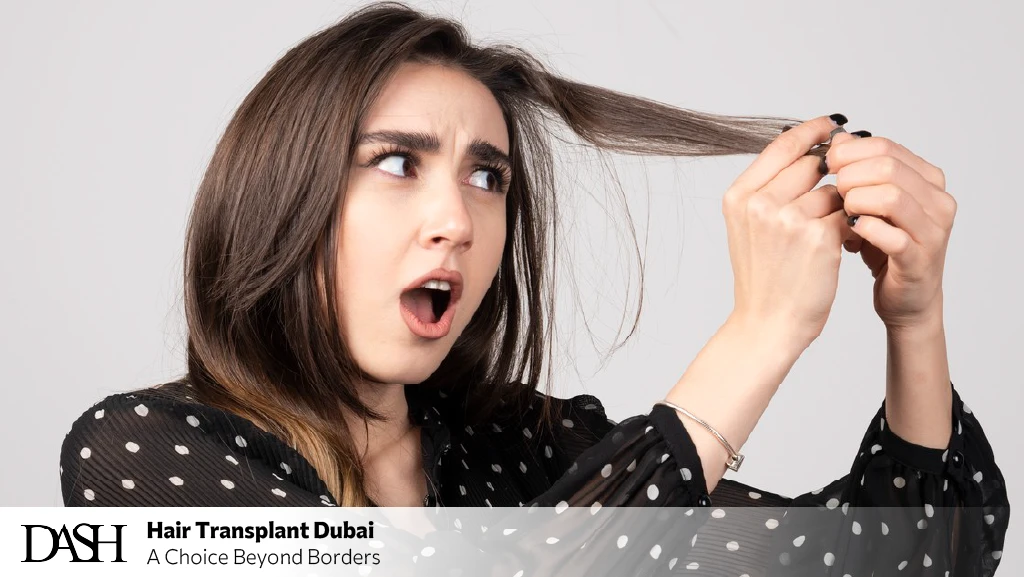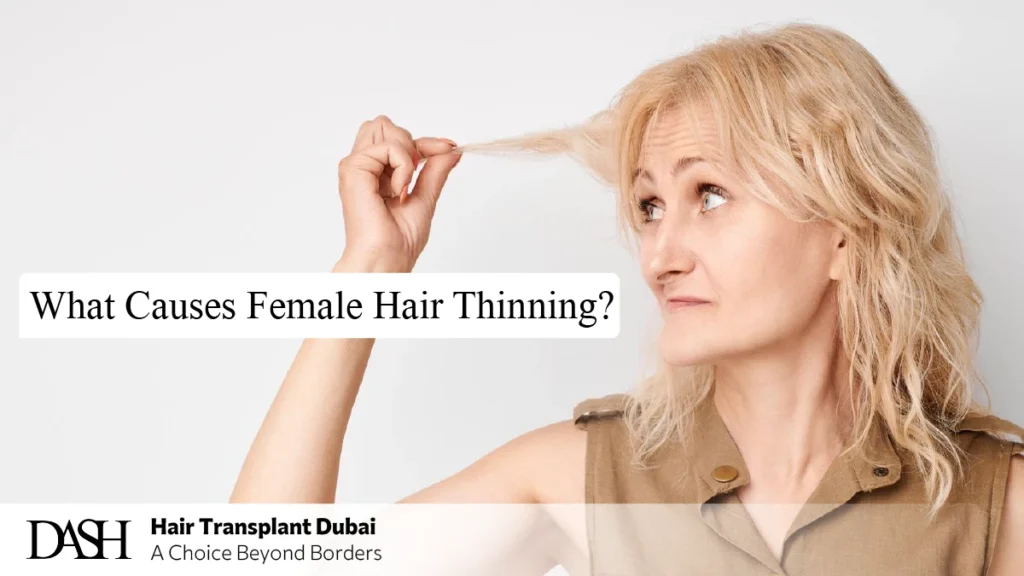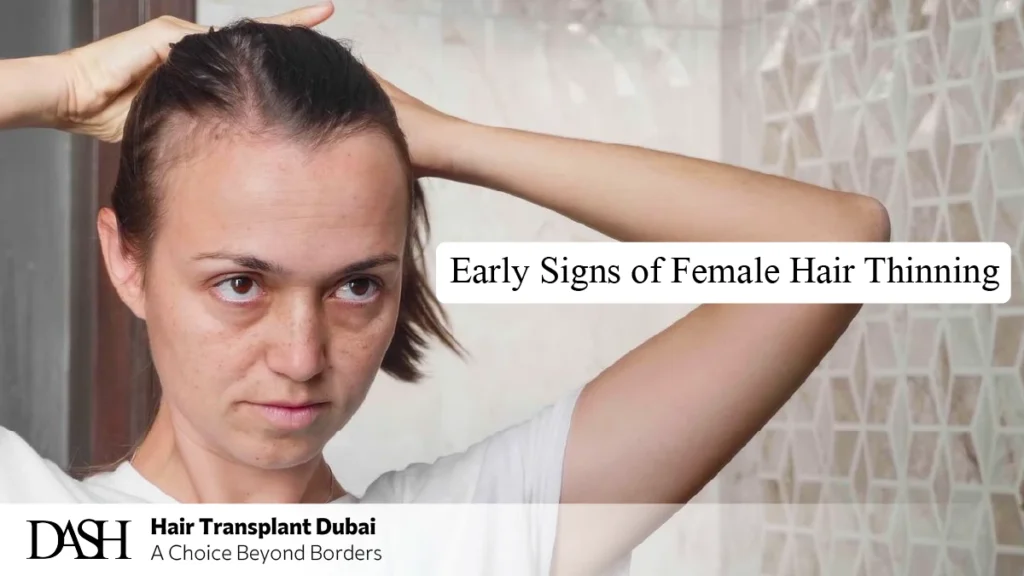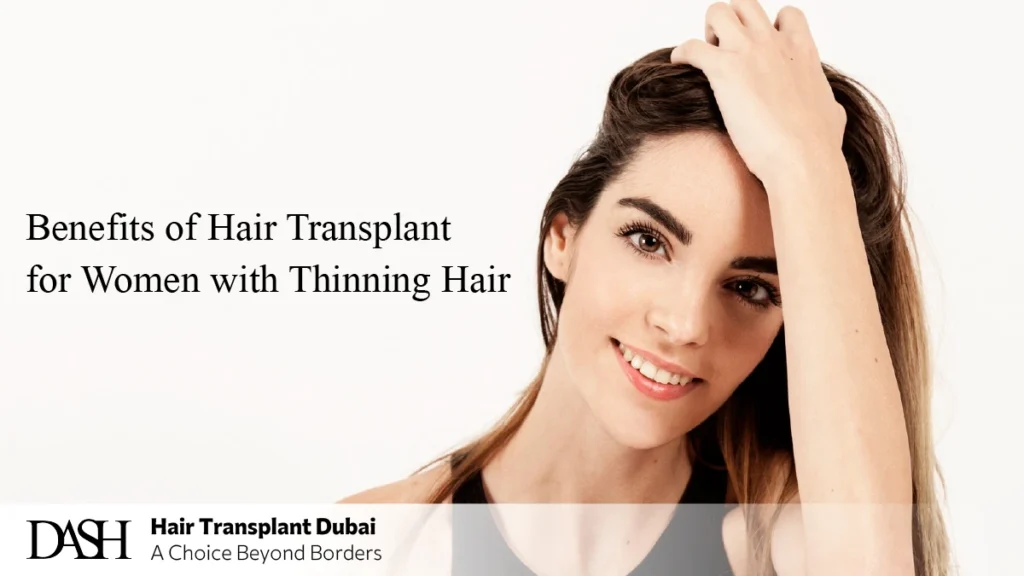Female Hair Thinning | When a Transplant Might?

Maybe you’ve noticed it each morning, your ponytail seems thinner, the parting in your hair a bit wider, or a glimmer of scalp peeking through what used to be private. What might begin as a minor change can slowly chip away at your confidence, turning everyday moments in front of the mirror into a source of stress.
Female hair thinning isn’t just a cosmetic issue it’s a signal that your body is undergoing changes. It might be genetic, hormonal, related to stress, or influenced by lifestyle. The good news? You’re not alone and you absolutely don’t have to settle for simply covering it up.
In this guide, we’ll break down what causes hair thinning in women, how to recognize when it’s more than just routine shedding, and the key markers that gut feeling, those telltale signs indicating it might be time to consider a hair transplant. If you’ve ever wondered whether that step makes sense for you, this is exactly the place to find out.
What Is Female Hair Thinning?
Female hair thinning refers to a gradual reduction in the density and volume of hair most noticeably along the part line, crown, or top of the scalp. Unlike baldness, which often results in clear patches of no hair, thinning is more subtle. The scalp becomes slightly more visible, ponytails feel lighter, and the overall look loses its fullness.
The key difference between hair thinning and baldness in women lies in the pattern and progression. Baldness usually involves complete hair loss in defined areas, while thinning is more diffuse and evenly spread. Most women don’t develop full bald spots like men do instead, they experience a slow, even reduction in hair coverage.
Hair thinning is often one of the earliest signs of changes in the body whether hormonal, nutritional, or genetic. It’s not always obvious at first, which is why many women overlook it until it becomes more advanced. But the earlier it’s identified, the more treatment options like hair transplants become viable and effective.
Female Hair Transplant in Dubai
What Causes Female Hair Thinning?
Hair thinning in women doesn’t have a single cause it’s usually the result of multiple factors working together over time. Some of these are internal and biological, while others are linked to everyday habits or health conditions. Understanding the root cause is the first step toward finding the right solution.

💠 Hormonal Imbalances
Changes in estrogen and progesterone especially during menopause, pregnancy, or due to conditions like PCOS can disrupt the hair growth cycle. When these hormones drop, hair may grow more slowly or begin to shed more noticeably.
💠 Genetics
Just like men, women can inherit a tendency for hair thinning from either parent. This condition is known as female pattern hair loss (FPHL) and usually becomes more noticeable with age.
💠 Stress and Lifestyle
Emotional stress, poor sleep, crash dieting, and smoking can all negatively impact hair health. High-stress levels can trigger telogen effluvium, a condition where hair prematurely enters the shedding phase.
💠 Nutritional Deficiencies
Low levels of iron, vitamin D, zinc, or protein can directly affect hair growth. Without these building blocks, follicles may become weak and less productive.
💠 Medical Conditions and Medications
Thyroid disorders, autoimmune diseases like alopecia areata, and even some medications (e.g., antidepressants or birth control pills) can contribute to thinning. Treating the underlying issue often helps improve hair density.
💠 Overstyling and Hair Damage
Frequent use of hot tools, tight hairstyles, chemical treatments, or harsh products can weaken hair over time, leading to breakage and visible thinning especially around the temples and crown.
Recognizing which factor or combination of factors is causing female hair thinning is essential for choosing the right treatment. At trusted clinics like Dash in Dubai, the first step is always a detailed diagnosis to ensure your hair restoration plan is truly personalized.
Early Signs of Female Hair Thinning
Hair thinning in women often starts gradually and that’s exactly what makes it so easy to miss in the early stages. Unlike sudden hair loss or visible bald patches, thinning creeps in quietly. But if you know what to look for, you can catch it early and take action before it progresses.

Here are some of the most common early signs of female hair thinning:
🔴 A Wider Part Line: If your part starts to look noticeably wider or more scalp shows through than before, this could be an early indicator that your hair density is decreasing.
🔴 Thinner Ponytails: Many women notice their ponytail feels smaller or lighter than it used to. This can signal a general reduction in hair volume.
🔴 More Hair in the Brush or Shower: Some shedding is normal but if you’re seeing more strands than usual on your pillow, in the shower drain, or after brushing, it’s worth paying attention.
🔴 Scalp Becoming More Visible: When styling or under bright lighting, if your scalp is more visible than it used to be especially on the crown or around the temples it may point to thinning.
🔴 Hair Becomes Limp or Fragile: Thinning hair often loses its strength and bounce. You may notice it doesn’t hold styles as well, breaks more easily, or appears dull and flat.
Spotting these signs early is key. The sooner you identify hair thinning, the more treatment options are available from lifestyle changes to medical therapies, and even hair transplant surgery if needed. At Dash Clinic, early evaluation means smarter, more effective care tailored to your hair’s future not just its past.
Female Hair Transplant in Dubai
Is Female Hair Thinning Reversible?
The short answer: sometimes depending on the cause. Female hair thinning can be reversible in many cases, especially when it’s linked to temporary factors like stress, nutritional deficiencies, hormonal changes, or certain medications. Once the underlying issue is addressed, hair growth often returns to normal over time.
For example:
- Stress-related shedding (telogen effluvium) usually resolves within months after the trigger is removed.
- Postpartum hair thinning often corrects itself within a year.
- Thinning due to iron or vitamin D deficiency can improve significantly with proper supplements.
- Thyroid-related hair loss often improves once hormone levels are balanced.
However, if thinning is caused by genetics like female pattern hair loss (FPHL) the process is typically progressive and not fully reversible on its own. In these cases, treatments like minoxidil, PRP therapy, or hair transplant surgery may be needed to restore volume and slow further loss.
The key is early diagnosis. At Dash Clinic in Dubai, specialists evaluate the root causes of female hair thinning before recommending a treatment plan so you get the best chance at regrowth, recovery, and long-term results.
When to Consider a Hair Transplant for Female Hair Thinning
Hair thinning can be frustrating, but it doesn’t always mean a transplant is the next step. Many women benefit from non-surgical treatments first. However, there comes a point when a hair transplant may be the most effective and long-lasting solution especially when thinning begins to noticeably affect your appearance and confidence.

Here are signs that it might be time to consider a hair transplant:
1️⃣ Non-surgical treatments aren’t working
If you’ve tried medications, PRP, supplements, or lifestyle changes without seeing meaningful results, a transplant could offer the next level of restoration.
2️⃣ Thinning is localized
Hair transplants work best for women with defined thinning areas like along the part, temples, or crown while the donor areas (usually the back or sides of the scalp) remain dense and healthy.
3️⃣ You’re experiencing progressive hair loss
If the thinning continues despite trying to manage it, and your scalp is becoming more visible over time, intervention may be necessary to prevent further loss.
4️⃣ You want a permanent solution
Unlike topical treatments that require ongoing use, a hair transplant offers a long-term, natural result with transplanted hairs growing like your own, for life.
5️⃣ Your self-esteem is taking a hit
Sometimes the emotional toll of hair thinning becomes too much. If your confidence, social life, or daily habits are affected, it might be time to explore a more definitive solution.
Female Hair Transplant in Dubai
At Dash Clinic in Dubai, every case is carefully evaluated before suggesting surgery. The goal is never to rush into a transplant but to offer it when it’s truly the right choice, based on your hair type, health, and expectations.
How Hair Transplant Works for Thinning Hair in Women
Hair transplant surgery for women with thinning hair is a precise and personalized process designed to restore fullness, volume, and confidence without changing your natural look. Unlike traditional balding patterns in men, women often experience diffuse thinning across the top and crown, which requires a more delicate and strategic approach.
Here’s how the process typically works:
🔰 Consultation and Hair Assessment: It all begins with a detailed evaluation. At clinics like Dash in Dubai, specialists assess your scalp, donor hair density, and the extent of thinning to determine if you’re a good candidate for transplantation.
🔰 Donor Area Selection: Healthy hair follicles are usually harvested from the back or sides of the scalp areas that are genetically resistant to thinning. These follicles retain their strength even after being transplanted.
🔰 Extraction Technique: Modern techniques like FUE (Follicular Unit Extraction) or DHI (Direct Hair Implantation) are commonly used. Both are minimally invasive and do not leave visible linear scars. Each follicle is removed individually, ensuring precision and faster healing.
🔰 Graft Placement: The extracted follicles are carefully implanted into thinning areas typically along the part line, crown, or temples. Surgeons pay close attention to the angle, direction, and density of placement to match your natural hair pattern.
🔰 Recovery and Regrowth: Mild swelling or redness may occur in the first few days, but recovery is usually quick. Transplanted hairs go through a natural cycle first shedding, then regrowing with visible improvements starting around 3–4 months and full results in 12–18 months.
Hair transplantation for women isn’t just about replacing lost strands it’s about restoring balance, femininity, and control over how you feel when you look in the mirror. And when done right, by expert hands, it becomes almost impossible to tell where the transplant ends and your natural hair begins.
Benefits of Hair Transplant for Women with Thinning Hair
For many women, thinning hair isn’t just a cosmetic issue it can be an emotional one too. A hair transplant offers more than just fuller hair; it restores confidence, self-image, and a sense of control. When non-surgical treatments no longer deliver the results you want, a well-performed transplant can be a game-changer.

Here are some of the top benefits:
✅ Natural-Looking, Permanent Results
Transplanted hair grows just like your natural hair because it is your natural hair. It can be washed, styled, cut, and colored. Once it takes root, it stays with you for life.
✅ Personalized Hairline Design
Especially in women, the shape and softness of the hairline matter. Skilled surgeons design hairlines that enhance facial features and maintain a feminine look.
✅ Boost in Confidence and Well-being
For many women, regaining hair means regaining a part of their identity. After a transplant, patients often feel more comfortable in social situations, at work, and in their daily routines.
✅ Low Maintenance
Once the healing process is complete, transplanted hair doesn’t require special care. No ongoing treatments or products are needed to maintain it.
✅ Safe and Minimally Invasive
Modern methods like FUE and DHI are gentle, require no stitches, and have minimal downtime. Most women can resume normal activities within a few days.
✅ Customizable and Scalable
Whether you have mild thinning or more advanced hair loss, the transplant procedure can be tailored to your specific needs. And if needed, additional sessions can be planned in the future.
At trusted clinics like Dash in Dubai, female hair transplants are performed with artistry, science, and compassion so that you don’t just see a difference, you feel it.
Female Hair Transplant in Dubai
Female Hair Thinning vs Female Pattern Baldness
Though often used interchangeably, female hair thinning and female pattern baldness are not exactly the same and understanding the difference is key to choosing the right treatment.
Female Hair Thinning
This is a broad term that refers to any gradual decrease in hair density. It can happen for a variety of reasons hormonal changes, stress, poor nutrition, certain medications, or medical conditions. Thinning can be temporary or long-term, and it often appears as a general loss of volume across the top or sides of the scalp without distinct bald patches.
Female Pattern Baldness (FPHL)
This is a specific type of hair thinning caused by genetics and hormonal sensitivity similar to male pattern baldness, but with a different pattern. Instead of receding hairlines or bald spots, women usually experience diffuse thinning along the crown and part line, while the frontal hairline stays intact. FPHL tends to progress slowly over the years and is typically not reversible without medical or surgical intervention.
Why the Distinction Matters
- Women with general thinning may respond well to lifestyle changes, topical treatments, or nutritional support.
- Those with pattern baldness often need long-term management and may be good candidates for hair transplant surgery especially if the donor areas are still healthy.
At Dash Clinic, we always start with a careful diagnosis to determine what type of hair loss you’re experiencing. That way, your treatment plan whether it’s non-surgical or involves a transplant is built specifically for your hair, your health, and your goals.
Can a Hair Transplant Prevent Further Thinning?
A hair transplant can permanently restore hair in thinning areas by using follicles from donor zones that are resistant to hair loss. However, it does not stop future thinning of your natural, non-transplanted hair. That’s why many women benefit from combining the procedure with supportive treatments like minoxidil, PRP therapy, or hormonal care. At Dash Clinic, the focus is not only on achieving fuller hair today—but also on helping you maintain long-term results.

Why Choose Dash Clinic in Dubai for Treating Female Hair Thinning?
When it comes to treating female hair thinning, choosing the right clinic makes all the difference—and Dash Clinic in Dubai stands out for a reason. Our approach is centered on personalized care, cutting-edge technology, and a deep understanding of the emotional and physical impact hair loss can have on women.
At Dash, every treatment plan begins with a detailed consultation and scalp analysis. Whether you’re just starting to notice thinning or have been struggling with it for years, our team customizes each step of your journey—from non-surgical therapies to advanced hair transplant solutions.
What sets us apart is not just our medical expertise, but our attention to detail. We design natural-looking, feminine hairlines that complement your features—and our minimally invasive techniques ensure fast recovery with lasting, beautiful results.
In a city known for world-class standards in beauty and wellness, Dash delivers both the science and the artistry that female hair restoration deserves.
Conclusion
Female hair thinning is more than a cosmetic concern—it’s a deeply personal experience that can impact how you feel every day. The good news is, you’re not without options. From identifying the early signs to understanding when it’s time to consider a hair transplant, taking action starts with knowledge and the right support.
Hair restoration is never one-size-fits-all. That’s why at Dash Clinic in Dubai, we offer personalized evaluations, advanced treatment options, and expert guidance every step of the way. Whether you’re just beginning to explore solutions or ready for a lasting transformation, we’re here to help you feel like yourself again—confident, empowered, and in control of your hair journey.
FAQs About Female Hair Thinning and Transplantation
Not always. It depends on the cause. Hormonal imbalances or stress-related thinning may be reversible, while genetic hair loss is usually progressive without treatment.
Yes. Treatments like minoxidil, PRP therapy, and nutritional support can slow down or reverse early thinning in many cases.
If you have stable donor hair (typically at the back of your scalp) and localized thinning, you may be a good candidate. A consultation is necessary to confirm.
Most women report only mild discomfort during the procedure, which is done under local anesthesia.
You’ll start to notice new growth around 3–4 months after the procedure, with full results visible in 12–18 months.
Yes. Once fully healed, transplanted hair behaves like your natural hair—it can be styled, cut, or dyed as usual.
Prices vary depending on the technique and number of grafts, but typically range from $2,200 to $6,800 USD.